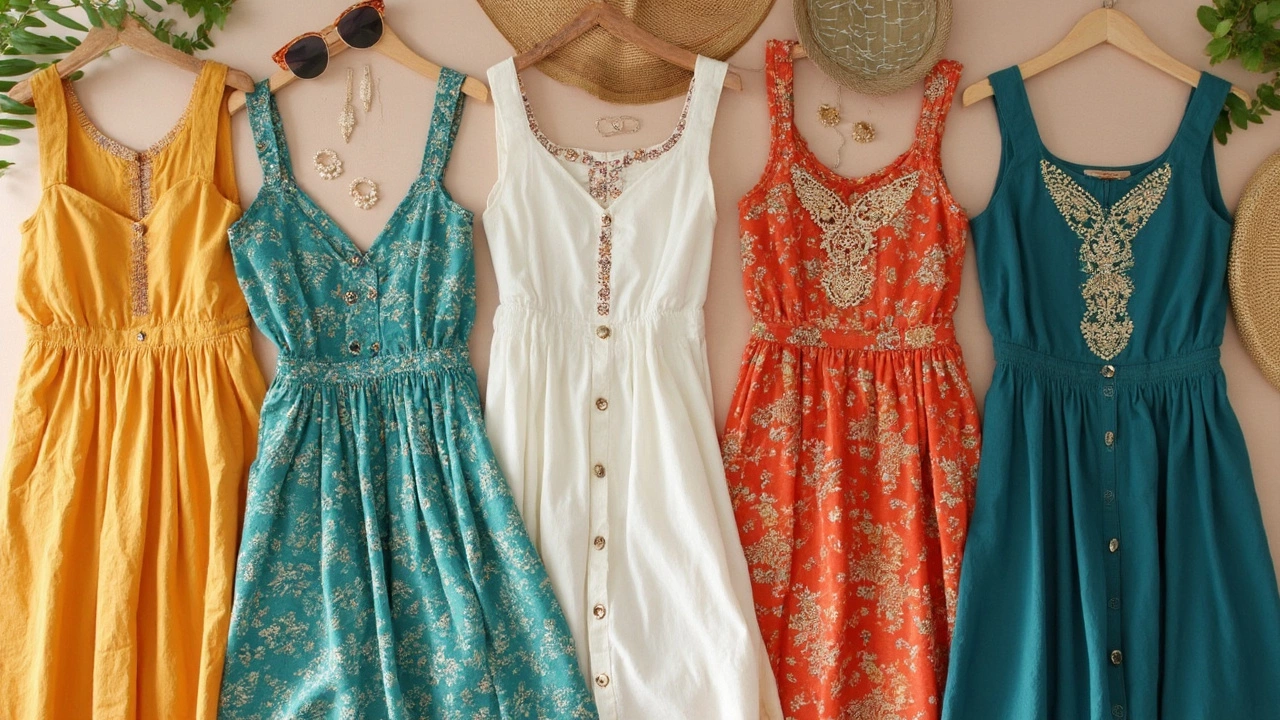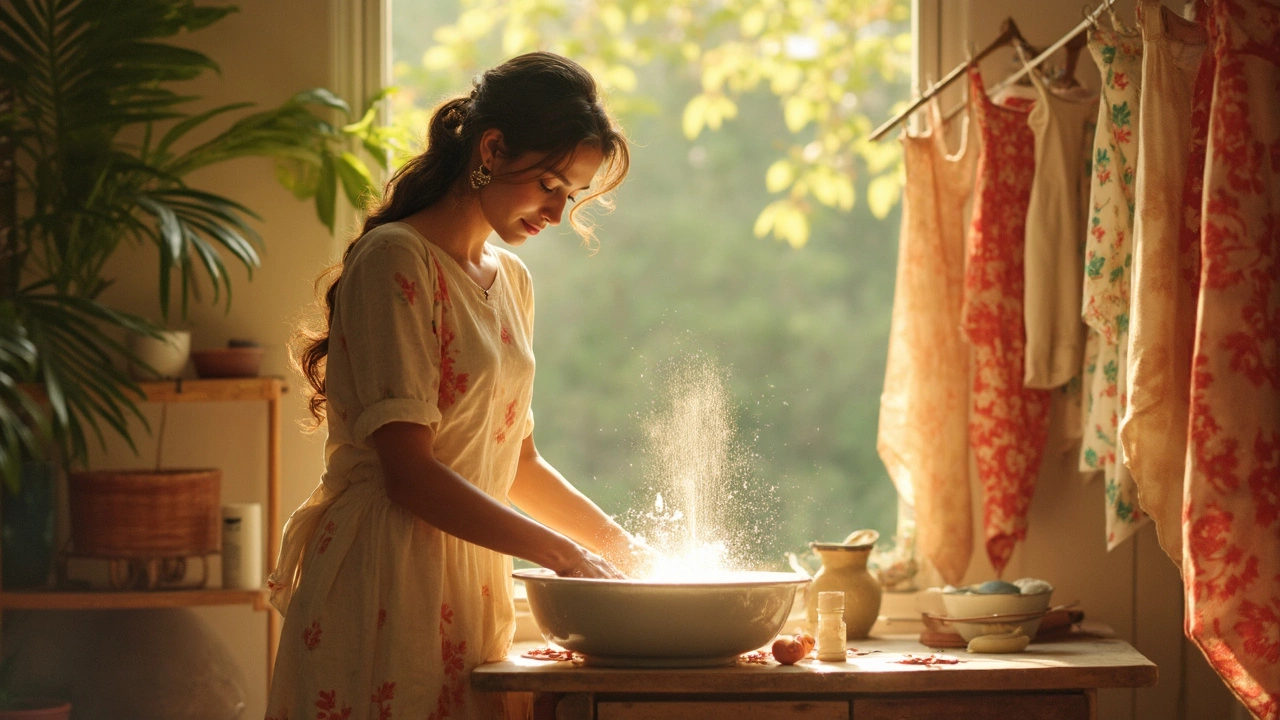Best Clothing for Extreme Heat: Summer Dresses That Actually Work

Ever felt like your outfit is working against you on a crazy hot day? It actually might be. Clothes can trap heat, hold onto sweat, and make you more miserable when the sun won’t quit. But the right summer dress can be a total game-changer if you know what to look for.
It’s not just about throwing on something cute—it’s about staying cool and comfortable when the temperature is out of control. The trick is picking fabrics and fits that help your skin breathe and stop sweat from sticking around. Knowing a few key points about material and style can mean the difference between feeling sticky all day or actually enjoying summer—even on those can’t-catch-your-breath afternoons.
- How Heat Affects Your Clothing Choices
- Best Fabrics and Why They Matter
- Styles and Fits That Beat the Sun
- Colors and Details for Maximum Comfort
- Easy Care Tips for Summer Dresses
How Heat Affects Your Clothing Choices
When the temperature starts climbing, your body switches to survival mode to stay cool. You sweat more, your skin warms up, and suddenly, what you wear matters a lot more than you thought. Picking the right summer dresses or lightweight clothes isn’t just about style—it’s about comfort and staying safe in the heat.
Here’s what happens: tight, clingy fabrics trap sweat and heat against your skin, making your body work even harder to cool down. If your dress isn’t letting air flow, you’re going to feel stuck in a sauna. Anything synthetic (think polyester) can make it worse by holding onto moisture—and nobody wants to walk around feeling damp.
Lightweight, loose-fitting clothing lets air move and sweat evaporate, which cools you off. If you ever wondered why people in the hottest places on earth wear roomy, layered clothes, it’s because they help control temperature and sun exposure at the same time.
Hot weather also makes your risk of heat rash and sunburn way higher, especially with the wrong fabrics or dark colors that soak up sunlight. The right hot weather style choices can actually help block UV rays or at least reduce your skin’s exposure.
| Clothing Factor | How It Affects You in Heat |
|---|---|
| Fabric | Natural, breathable materials cool you down. Synthetic ones trap heat. |
| Color | Lighter shades reflect sun; dark absorbs heat. |
| Fit | Loose fits allow air to move and sweat to dry. |
| Length | Shorter or midi options let more skin breathe but longer, loose styles can protect from sunburn. |
If you’re outdoors a lot, pay attention to how the sun hits your body. The more your dress covers—while staying breezy—the less chance you’ll have of burning or overheating. So, when picking summer dresses for extreme heat, the goal is always light, loose, and layered smartly.
Best Fabrics and Why They Matter
If you want to make it through extreme heat without melting, what your summer dress is made from is a big deal. Not all fabrics perform the same in real-world sweat and sunshine. Some actually trap heat (hello, polyester), while others keep things way breezier.
The safest choices for hot weather style are natural fibers. Cotton is the classic for a reason: it’s lightweight, breathes well, and doesn’t cling to your body when you start to sweat. Lots of people also love linen during a heatwave. Linen dries even faster than cotton and feels cool to the touch, even when humidity is through the roof.
There’s also rayon—a semi-synthetic made from plant stuff. Rayon is super lightweight and flowy, making it awesome for dresses that you want to move and breathe with you. One thing: rayon can wrinkle fast and sometimes feels damp, but if the choice is between that and overheating, I know which one I’d pick.
Just avoid heavy blends or full-on synthetic materials like polyester and nylon. These trap heat and don’t let sweat escape, so the misery factor just goes up. If you're checking a label and see “moisture-wicking,” that sometimes helps—but nothing beats natural fibers for pure breathability.
| Fabric | Breathability | Drying Speed |
|---|---|---|
| Cotton | High | Moderate |
| Linen | Very High | Fast |
| Rayon | High | Fast |
| Polyester | Low | Varies |
So next time you shop for summer dresses, aim for breathable, loose, and as natural as you can get. Your skin (and your mood) will thank you.

Styles and Fits That Beat the Sun
If you’ve ever regretted wearing a body-hugging dress in July, you’re not alone. When it comes to summer dresses for extreme heat, looser is almost always better. Flowy silhouettes actually let air move over your skin, helping sweat dry faster and keeping you cool. Think shifts, A-lines, and anything labeled “relaxed fit.” Maxi dresses are great, but only if they’re not clinging to your legs—fabric that moves when you move is your best friend in the heat.
Another big win: dresses with cut-outs, open backs, or fluttery sleeves. Not only do they look cute, but skin that’s exposed to the air cools off much faster than skin trapped under fabric. Just watch those strappy designs if you burn easily—a little extra sunscreen never hurts.
Here’s a quick no-fail checklist for choosing summer dresses that beat the sun:
- Loose fits: Say no to skin-tight. Roomy shapes stay cooler.
- Length that works for you: Short dresses keep your legs cool, but flowy midis let air travel up underneath—both good choices.
- Breathable sleeves: Cap sleeves and sleeveless options let your arms breathe, but flutter sleeves and wide arms are helpful if you want some sun protection too.
- Open necklines: Scoop necks, V-necks, and off-the-shoulder styles all let heat escape.
Researchers from the University of Florida compared clothing styles in high-heat regions and found that people who wear loose, light layers actually sweat less than those piling on tight gear. So if you’re tossing up between a tight tank dress and a roomy sundress, always go for extra space.
And don’t forget about pockets. Not just a convenience! Deep side pockets mean you won’t need an extra bag bumping against your sweaty skin, which can actually help you stay a little cooler.
Here’s a snapshot of what works (and what to avoid):
| Cool-Approved Styles | Styles to Skip |
|---|---|
| Loose cotton maxi | Fitted knit bodycon |
| Flowy A-line midi | Heavy denim shifts |
| Sleeveless sun dress | Long sleeves in thick fabrics |
| Open-back designs | Layered ruffles in polyester |
One last tip—a dress that shows sweat stains less (like prints or patterns) means less stress for you. Trust me, you’ll thank yourself on those blazing afternoons.
Colors and Details for Maximum Comfort
Ever notice how black shirts make you roast in the sun, but a white dress feels way cooler? Color isn’t just about style—it’s actually science. Lighter colors like white, beige, pale pink, and light blue reflect sunlight instead of soaking it up. That means you’ll stay cooler if you swap out those dark shades for something lighter, especially when you're picking summer dresses for extreme heat.
It’s not just about color, though. The details in a dress can make a real difference too. Think loose sleeves instead of tight ones and button-down fronts or wrap styles that let a breeze sneak in. Deep V-necks and scoop necklines aren’t just cute—they actually help cool air hit your skin, which you’ll appreciate when it’s muggy out.
Don’t overlook the magic of pockets. Sounds small, but sweaty hands are no fun, and roomy pockets let you stash a hair tie, sunglasses, or even blotting paper without weighing down your bag. Plenty of designers now add hidden vents, mesh lining, or underarm cutouts to boost airflow even more. If you see a dress with these features, you’re on to something good.
Here’s a simple look at how color can affect how much heat your dress absorbs under direct sunlight:
| Dress Color | % of Sunlight Absorbed |
|---|---|
| Black | 95% |
| Navy Blue | 90% |
| Light Gray | 35% |
| White | 5% |
Patterns matter, too. Bold prints or stripes in light shades keep things fun while still bouncing the heat away. If you’re worried about sweat marks, busy prints hide them better than plain fabrics.
- Stick to light, reflective colors in your summer dresses.
- Look for relaxed fits, deep necklines, and extra airflow features.
- Pockets and well-placed vents = bonus comfort points.
- Choose busy patterns to downplay sweat if that's something you worry about.
It all adds up to a lot more comfort, so you can spend less time thinking about sweat and more time actually enjoying summer—no matter how high the temperature climbs.

Easy Care Tips for Summer Dresses
When you’re wearing summer dresses in extreme heat, laundry is nonstop. But if you want your favorite outfits to stick around for more than one season, you’ve got to treat them right. Here’s what actually works.
First, always check the care label. That tiny tag shows if your dress wants cold water, tumble dry low, or good old-fashioned line drying. Most lightweight cotton and linen dresses love a cold-water wash and air drying—this keeps things from shrinking and the fabric from wearing out.
According to The Good Housekeeping Institute, “Washing in cool water and line drying is the best way to keep cotton and linen dresses looking fresh and prevent fading.”
Ironing in summer sounds like torture, but wrinkly dresses don’t always look cute. If you hate ironing, hang your dress in the bathroom while you shower. The steam helps wrinkles fall out, especially for linen or rayon. For dresses made with synthetic fibers (like polyester blends), a quick shake and smooth after washing usually do the trick—you barely need to iron these at all.
Let’s talk stains for a sec. Sunscreen and sweat can leave weird marks—especially on lighter colors. Tackle stains ASAP with a gentle stain remover (a dab of dish soap works in a pinch for greasy spots). Don’t let stains bake in by leaving them for wash day.
Here’s a super easy cheat sheet for keeping your summer dresses in top shape:
- Wash on gentle cycles with similar colors—cold water is your best friend for most summer dresses.
- Avoid heavy-duty detergents. They can break down lightweight clothes and fade bright shades.
- Skip the dryer if you can. Hang or lay flat to dry—direct sun keeps them crisp, but shade is better for deep colors.
- Spot clean sweat and sunscreen stains right after you take the dress off.
- Fold or hang dresses so they keep their shape. For delicate straps, use padded hangers.
If you’re curious about which fabrics stand up best, check this out:
| Fabric | Wash Setting | Drying Method |
|---|---|---|
| Cotton | Cold, Gentle | Line Dry |
| Linen | Cold, Gentle | Flat or Line Dry |
| Rayon | Cold, Hand Wash | Hang in Shade |
| Polyester Blend | Warm or Cold | Low Tumble or Line Dry |
A few habits go a long way—keeping your hot weather style looking fresh all summer without burning through your favorite pieces.
- Apr, 29 2025
- Violet Greenfield
- 0
- Permalink
Written by Violet Greenfield
View all posts by: Violet Greenfield